Das Projekt Patio 13 / Das Projekt in der Presse / 2005
Das Projekt in der Presse
Übersicht
2005
- Proceedings of the NARST 2004 Annual Meeting (Vancouver, BC, Canada): Colombian Teacher Students Develop Teaching Sequences in Physics for Street Children – An International Project
- El Espectador, 26. Juni 2005: "Con
imágenes dan a conocer su realidad. Los niños
de la calle se revelan"
Proceedings of the NARST 2004 Annual Meeting (Vancouver, BC, Canada)
Colombian Teacher Students Develop Teaching Sequences in Physics for Street Children – An International Project
The basis of our study is the international collaboration of the University of Education Heidelberg (Germany) and the Escuéla Normal Superior Maria Auxiliadora in Medellín (Colombia) in the field of teacher education. One important objective is to develop teaching sequences for street children in co-operation with primary teacher students of the Colombian institution. During the past two years a sequence on electrical circuits was developed, implemented and evaluated. The theoretical background is a constructivist one: the students as well as the street children start to make own experimental experiences with various material offered. In small groups of learners theories are discussed about certain properties of electrical devices and rules. To get more information about learning characteristics of street children the learning processes of the students and of the street children have been documented through video graphing and protocols of observation. Differences between the learning processes of pre-service teacher students and street kids got visible.
Elmar Breuer, University of Education Heidelberg
Manuela Welzel, University of Education Heidelberg
Antony Crossley, University of Education Heidelberg
Hartwig Weber, University of Education Heidelberg
Objectives
The basis of our study is the international collaboration of the University of Education Heidelberg (Germany) and the Escuéla Normal Superior Maria Auxiliadora in Medellín (Colombia) in the field of teacher education. One important objective of this project is to develop and evaluate teaching sequences for street children in co-operation with primary teacher students of the Colombian institution. With this objective in mind, we organized a seminar where Colombian pre-service teacher students learned by themselves specific physics contents (on electric circuits and electromagnetism) through the use of experimental material and in a very interactive way. Because of a more theoretical way of science education in Colombian schools this was a new approach for these learners. Afterwards, based on these own learning experiences, the teacher students developed learning sequences for street children and taught these sequences within an institution called “Patio 13” where Colombian street children can spend the days.
To get more information about learning characteristics of street children (e.g. compared to those of the teacher students of our course), the learning processes of the students have been documented through video graphing and the learning processes of the street children in the patio have been documented through protocols of observation. In both groups we took photographs in all sessions. The knowledge about the learning characteristics of street children will help us to develop a specific pedagogy for street children.
Significance
The number of street children in the world is increasing rapidly. Especially in Colombia with its civil war lasting for several decades, lives a high number of children without parents, homes and education. They are mainly concentrated in large cities. In these cities exist social institutions (so-called “patios”) which take care of these children and offer them clothes, food, shelter and health services. But, mostly there are no educational offers (Weber & Sierra Jaramillo 2003). The Colombian project “Patio 13” situated in Medellín intends to go further: Social and educational scientists from Colombia and Germany are working together to develop a program where street children get a regular instruction in mother tongue, mathematics, arts and natural sciences during their stay in a patio. These offers are special in a way that the children are free to participate or not. In general, the instruction is not organized like a traditional classroom lesson. It is oriented to the interests and motivations of the street children and organized very interactive. The idea is to improve the social situation of those children through education starting from their individual situation. For us the importance of this project is to learn more about the life and the learning of street children. What do they need? How to work with them? How to improve their situation?
With this project we expect to get results which are helpful to give street children a better chance for their individual development and a better future.
Theoretical Background
Roth (1995) showed that authentic learning environments are necessary for an effective learning context. School science therefore needs authentic learning environments for school children with their specific experiences inside and outside of school. Coming from this (constructivist) perspective, we postulate that street children also need a specific authentic science education, which is based on their specific experiences, motivations and interests. They do live a life that's fundamentally different from the life of children with a family background. With respect to the special experiences of street children in being active and self sufficient and in most cases to the absence of scholar education we preferred a hands-on-approach for them to get into physics.
Pre-service teacher students in Colombia and all over the world in general don't have “street experiences”. They experience a “normal” school career, and they study at Universities to become teachers for “normal” schools. As in many countries so in Colombia the educational system is traditionally developed in a way that children living outside are kept outside. For being able to educate street children and to design appropriate teaching-learning environments, teachers have to know more about the life and the learning of street children. Within our project learning characteristics of street children compared to those of the teacher students in a rather similar learning setting have been investigated.
Learning process studies and action research from the past years (Welzel 1997, 1998, 2000; von Aufschnaiter 1999) could show that individual learning proceeds in general as situated cognition processes from lower complex to higher complex cognitions in certain learning contexts. A development of meanings along complexity levels could be observed which reaches from concrete experimental experiences up to theoretical discussions. Linking our project on physics education for street children to these results, learning processes could be organized from lower to higher complexity levels. To that end, the street children have to start in new contexts with physical experiences (with hands-on-material). They have to communicate their observations. Thus, they can differentiate physics objects and their properties. On this basis they will start to develop experimental programs step by step, before they are able to find physics principles.
“Our” Colombian teacher students especially experienced only a pure theoretical approach to physics in their classes. For that reason they also have to experience the experimental approach and to learn how to teach with hands-on-experiments.
Design and Procedure
We draw on practice theory (Bourdieu 1990) to understand both teaching and reflecting on teaching as different practices. The pre-service teacher students have to understand more than these two different levels of teachers' activities: Firstly, they have to learn a hands-on physics approach to be able to teach it, then they have to design teaching sequences with appropriate material and to teach them, finally they have to reflect on their teaching according to the learners specifics. This procedure in mind, we started our project with a two week instruction for the pre-service teacher students. We presented a suitcase full of experimental material for electricity: e.g. bulbs, cables, switches, batteries, wires, resistors, LED's, NTC's, LDR's, compasses, thick nails, measuring instruments for currant and voltage, paper clips, and others. Using these devices, the pre-service teacher students learned actively and guided by a succession of tasks and theoretical reflections the physics of electric circuits and electromagnetism. They discussed about their own learning experiences, their experiences with street children, the abilities and behavior of the street children, and they constructed learning sequences on their own. All the time the students worked in small groups (Fig. 1, 2).
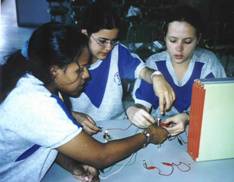
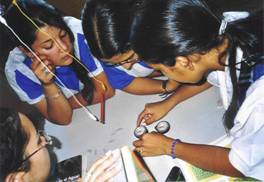
Figure 1, 2: Colombian pre-service teacher students learning physics and preparing teaching sequences for street children
The activities of the teacher students have been video graphed. Through (inter-)active situations and reflections on the teaching-learning situations, the students learned how to come from experimental experiences to theoretical explanations. Into this process they brought in their own experiences with street children. Developing the instructional design by themselves and reflecting the teaching-learning situations the teacher students started to think about and to understand the relationship between learning and teaching.
Twice a week, the pre-service teacher students in Medellín have to do practical courses in the patio. There, they offer different subjects to the street children –in the fields of mathematics, mother tongue, arts, and others. In a seminar which is organized in parallel to these practical courses they discuss their teaching and the experiences with the street children. Some of the pre-service teacher students of our project started to realize their physics lessons within this patio. The activities of both, the teacher students and the street children within these situations have been observed and photographed (Fig. 3, 4).
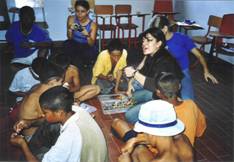
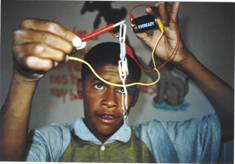
Figure 3, 4: Pre-service teacher students teaching physics to street children
Findings
According to our objectives, we observed the learning processes of the pre-service teacher students learning physics and of the street children in the Patio. We now focus on commonalities and differences between the two groups of learners.
In general, both groups - the teacher students and the street children - benefited by the interactive offers. The material seems to motivate physics learning. All of the learners used the experimental devices intensively over long time periods. They became able to construct electric circuits with one and more bulbs, switches and batteries, and constructed electromagnets according to the tasks. They did vary the experiments by themselves creating own ideas. All showed that they have been happy and proud about their successes.
However, differences between the learning processes of the pre-service teacher students and street children got visible. Crucial points are the social behavior, the organization of group work, the communication within the groups about the physics background, the creativity and the variety of experimental activities.
Street children
At the beginning of their teaching, the pre-service teacher students tried to teach the street children using frontal situations. Immediately, we could see the problem: the street children were not able to concentrate themselves over longer periods of time sitting on chairs or on the floor. The strategy had to be changed into more interactive hands-on situations. The street children are used to be organized (“living”) in small groups and to do the things together within these groups. But, doing physics rivalries within the small groups got visible, because everybody wanted to get material and to do everything by himself. We could not observe any communication within the groups about the physics background of the experiments. But, we could observe that the street children have been working concentrated with the devices offered over more than 30 minutes of time (much longer than expected by us), and they have been highly amazed about the physics effects they produced. At the end of their experiments they have been proud of their results. Repeatedly, the children presented their experimental results to the others and to the teachers. After having realized the given tasks lots of children started to vary immediately their experiments. They have been much more spontaneous and creative in this kind of situation than the pre-service teacher students at school.
Pre-service Teacher Students
Looking at the behavior of the teacher students, we found that they did not have any problems with frontal situations and group work. They have been very concentrated and co-operative while working frontal. To organize small groups, some discussions have been necessary about the “who with whom”. Within the groups formed roles have been distributed rapidly: writer, experimenter, explainer. All groups worked very close to the instructions given by us. The teacher students mostly stopped their activities after having solved a certain problem and waited for further instructions. According to our theory and because of the lack of experimental experiences the teacher students too, started to learn physics within the experimental contexts at a low level of complexity. Theoretical knowledge of former physics instruction was seldom used. The teacher students started with simple operations and increased their levels up to theoretical explanations. We could observe that some of the groups did discuss the physics background of the experiments intensively. The teachers (we) have been asked by the students for further explanations, textbooks got used, explanations have been discussed within groups and shared by the group members.
The Pre-Service Teacher Students Teaching Street Children
Looking at the teaching sequences developed and taught by the Columbian teacher students we find a few interesting aspects. Designing their learning sequences the students mixed ideas and tasks from the instruction they got from us, from further experiences with street children, and with own learning at school. For example, they started frontal to give inputs (own school experience), they organized experiments to activate the street children (experience with our approach) and they used games to motivate and to visualize physics phenomena (experience with the behavior of street children).
Reflecting on their instruction these teacher students rapidly realized the difficulty of starting a lesson frontal with street children. They had problems to keep the street children motivated and concentrated listening. Observing the activities of the street children within experimental situations, the teacher students learned that the experimental approach leads to an extensive engagement in physics problems. One teacher student recognized that it is helpful if the street children can take the experimental material by themselves instead of getting it allotted. The teacher students observed long and intensive periods of dealing the context while experimenting at the side of the street children. To come to theoretical explanations, it got obvious that visualizations are necessary. These visualizations can be made through games.
References
Bourdieu, P. (1990). The logic of practice . Cambridge, UK: Polity Press.
Roth, W.-M. (1995). Authentic school science: Knowing and learning in open-inquiry laboratories . Dordrecht, Netherlands: Kluwer Academic Publishing.
von Aufschnaiter, S. (1999). Development of Complexity by Dealing with Physical Qualities: One Type of Conceptual Change? In: Komorek, M. et al. (Eds.). Research in Science Education: Past, Present, and Future. Proceedings of the Second International Conference of the European Science Education Research Association (E.S.E.R.A.), Vol. 1. Kiel: IPN, 61-63.
Weber, H. & Sierra Jaramillo, S. S. (2003). Narben auf meiner Haut. Straßenkinder fotografieren sich selbst. Frankfurt, Wien, Zürich: Büchergilde Gutenberg
Welzel, M. 1997: Student centred instruction and learning processes in physics. Research in Science Education. 27(3). 383-394.
Welzel, M. 1998: The emergence of complex cognition during a unit on static electricity. International Journal of Science Education. Vol. 20, 9, 1107-1118.
Welzel, M. 2000: Systematic analysis of instructional design: The influence of interactions on students‘ cognitive processes. In: Systematic analysis of and reflection on „emergent practices“ of instructional design. Papers presented at the symposium „Systematic analysis of and reflection on „emergent practices“ of instructional design . EARLI Conference, August 1999, Sweden. Universiteit Leiden. 23-36.
El Espectador, 26.
Juni 2005: "Con imágenes
dan a conocer su realidad. Los niños de la calle se revelan"
von Alfonso Rico Torres
Así empieza esta historia.
“A principios del año 2002, le propusimos a unos
niños que, en medio de millones de habitantes que andan
y viven por el centro de la ciudad de Medellín, nos contaran
sobre sus vidas con fotos tomadas por ellos mismos”.
De esta manera, dos personas,
el alemán Hartwig Weber y la colombiana sor Sara Sierra
Jaramillo cuentan como inició el proyecto para que los
denominados niños de la calle de Medellín contaran
sus historias con imágenes.
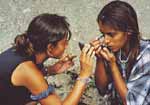
Hoy, tres años después,
ese proyecto es una realidad traducida en el libro Cicatrices
en mi piel; los niños de la calle se fotografían
a sí mismos. Éste ya fue publicado en Alemania
y saldrá a la venta en Colombia a finales de este mes.
En el libro se pueden observar
cerca de 70 fotografías tomadas por ellos mismos. Imágenes
que dan cuenta de la situación de pobreza con tal sólo
ver a uno de ellos durmiendo en un cementerio, debajo de un
puente o en un andén.
Pero también hay fotografías
y relatos positivos. Niñas que cuidan de su belleza,
jóvenes que buscan a toda costa mantener blancos sus
dientes, historias de lealtad entre ellos mismos, de buenos
momentos.
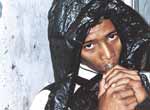
Al final del libro, los autores
intentan dar una explicación a la situación por
la que atraviesa el país y el porqué de esa situación
de indigencia. Hablan del frustrado proceso de paz con las Farc,
del narcotráfico, de las drogas y, en general, de todas
los problemas que afronta Colombia.
El Espectador dialogó
con los dos autores del libro acerca de la publicación.
Uno de ellos es la hermana Sara Sierra, rectora de la Escuela
Normal Superior de Copacabana en Medellín.
“La investigación
se realizó desde el segundo semestre de 2001 hasta 2003.
La iniciativa surgió de dos intereses diferentes en perspectiva,
pero comunes en el objeto. El profesor Weber venía realizando
algunos estudios sobre los niños de la calle en Bogotá
y, en el caso de la Escuela Normal, estábamos interesados
en redimensionar la formación de maestros en el campo
social”.
El alemán Hartwig Weber,
profesor de teología en la Universidad de Heidelberg
de su país y quien dialogó con este periódico
desde Gleisweiler, en la frontera entre Francia y Alemania,
lo recuerda de otra manera. “Sor Sara y yo nos conocimos
en Bogotá en un congreso, en el año 2001. Sor
Sara había traducido una novela mía sobre un niño
de la calle, con el título Punto de encuentro: Plaza
de Bolívar. Decidimos seguir con el contacto y empezamos
a desarrollar un proyecto sobre niños de la calle”.
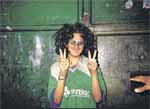
De esta manera surgió
Patio 13 y luego, el libro. El primero, según Jaramillo,
“es un proyecto de carácter pedagógico y
social que tiene una doble intencionalidad: la formación
de maestros para la atención de niños y jóvenes
vulnerables y la construcción de una pedagogía
para esta población”. Éste ha contado con
financiación de la Universidad de Heidelberg.
En cuanto al libro se refiere,
primero fue publicado en Alemania en el año 2003. La
razón, la explica Weber: “En mi país y en
otros de Europa, también hay niños de la calle,
una sorpresa para los europeos. Ellos no habían pensado
en la posibilidad de que algún día iban a encontrarse
niños abandonados en sus mismas ciudades. Por eso no
saben como tratar este problema. En Colombia se conoce el fenómeno
desde hace cien años. Es una causa por la cual los alemanes
pueden aprender de los colombianos”.
Sus historia
El común denominador
del hecho de que los niños estén en las calles
es la violencia. Muchos de ellos salieron de su casas huyéndole
a la golpiza de su padrastro o al insulto de su madre. También,
en busca de un futuro prometedor.
Ya fuera de sus hogares, son
frecuentes las historias que el libro reseña sobre las
riñas callejeras, los amores prófugos y la adicción
al pegante.
Cada niño habla de sus
cicatrices con orgullo. Son el recuerdo imborrable de su valentía,
la huella que los identifica como sobrevivientes de la calle,
la marca que implica respeto. Prácticamente todos la
tienen. De los 6.000 niños que deambulan por las calles
de Medellín, según cifras oficiales, pocos no
la llevan consigo.
De esa misma cantidad, 3.636
son declarados en estado de abandono y sufren diversos tipos
de enfermedades. De hecho, en el libro se cuentan varias historias
de niños que están a punto de perder la vista,
de otros cuya adición al pegante el del ciento por ciento
y de muchos males que ellos esperan que se curen por sí
mismos.
Según la hermana Sara
Sierra, “lo más agradable de trabajar con niños
de la calle es descubrir que en ellos existen deseos y sueños,
los cuales parecen encontrar posibilidades de realización
cuando se establecen relaciones fraternas y cálidas y
se les propician condiciones para que vivan como personas”.
Para el profesor alemán, “el trabajo con niños
de la calle es, en verdad, bastante fácil. Los niños
de la calle se alegran cuando se busca el contacto y habla con
ellos”.
En cuanto al libro, ya fue
solicitado por algunas editoriales en España e Italia
luego de conocer una exposición fotográfica de
los niños hecha en Alemania y que se volverá a
hacer en Roma.
Mientras tanto, los autores
del escrito seguirán trabajando en busca de que algún
día esos niños sean valorados como personas.
![]()
![]()
![]()
![]()